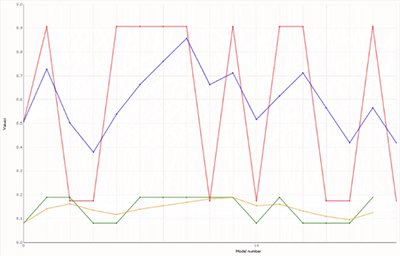In addition to manual cross-validation, where you can manually deselect a well, perform the depth conversion, then assess how well the depth has been predicted at the de-selected well, there is an automated “Combinations” option introduced in the 2017 release of Velit, our Depth Conversion Software package.
This new feature lets you choose your defined methods and compare them for stability in terms of their residual well-tie error when the well has been dropped. You can specify how many tests to run & generate a histogram of the number of wells to drop for each test, and select the methods you have already run to test against each other. Spatial bias through clustering of wells can be mitigated using a Distance filter, and statistics computed.
It can be seen in the image that the X-axis displays models with an increasing number of wells dropped; on the Y-axis, the standard deviation of the residuals is displayed; that is, the difference between the depth conversion and the well formation tops. There is a coloured data set for each method; the green line is the method that consistently gives the smaller residuals, and is the Interval vs Isochron method in this case.
You can see that with fewer & fewer wells, the errors do increase, but with our dataset it’s reasonably stable. The Optimisation technique, in orange, looks more stable with decreasing amounts of wells, but gives consistently larger residuals than the interval velocity vs isochron method in this dataset. The blue line, the interval velocity vs depth to middle of layer method, is stable but errors are on average 20m worse than the first method. The red line represents mapping and show considerable variability, even when we have lots of wells.
In this example, you could conclude the interval velocity vs isochron is probably a good option to use here.
For more information on the Combinations tool for cross-validation, click here, or contact us on support@equipoisesoftware.com for more information.

